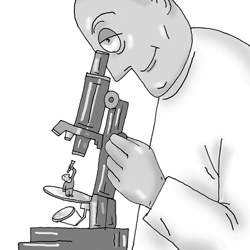In this chapter:
- Introduction
- Learning from nature
- Peering into nature’s secrets

Roaming a molecular-scale kingdom, nanotechologies may change the face of health care
In the future, biologists will use assembler-built nanomachines to probe and modify living cells.
- Eric Drexler, Engines of Creation, 1986
Having devised nanomachines capable of manipulating single atoms and molecules and begun to apply these technofeats to modify the material world around us, scientists are now shifting their gaze inward, to the human body. They envision nanorobots coursing through our bodies able to fix dangerous mutations on the spot, cleanse blood vessels or secrete insulin to counter an abnormal rise in blood sugar levels.
The quest of nanomedicine, however, has had its fair share of controversial enthusiasts, offering grandiose scenarios of future medical therapies. Set in motion by Richard Feynman’s 1959 lecture on miniaturization (see p. 7), it captured popular imagination and picked up speed following Isaac Asimov’s Fantastic Voyage (1966). This science fiction classic describes a crew of miniaturized humans rushing to save Professor Beans, a miniaturization expert who has suffered a life-threatening blood clot deep in his brain. The rescue team navigates through Beans’ circulatory system in an atomic-scale submarine.
Eric Drexler addressed the implications of new nano technologies in his classic “Engines of Creations“ (1986). His logic was simple: “Being made of molecules… we will apply molecular machines to biomedical technology… [these] machines will combine sensors, programs and molecular tools to examine and repair the ultimate components of individual cells.”
At the time, most of his ideas were deemed far-fetched at best, but now, nearly 20 years later, prototypes of his proposed scenarios are beginning to pop up in research labs around the world. At the Weizmann Institute of Science, researchers have created a tiny computer built of DNA molecules that detects prostate cancer conditions in a test tube. And elsewhere in the nanoscience world, researchers are working to create soap-like films to encapsulate drugs that could deliver their medicinal cargo right on target. The films would protect the drug in the bloodstream, releasing it only under certain chemical or thermal conditions, thus preventing wholesale release of a potentially toxic drug. Other nanotools may identify the presence of bacteria and viruses, which, like many biological particles, have well-defined electrical properties and thus oscillate in characteristic ways when exposed to an electric field.
Numerous challenges remain - technical, scientific and even psychological - until nanomedicine will directly influence healthcare. Here’s a look at some of the early steps taken here at the Institute.






















